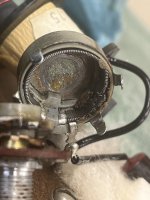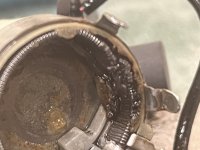I have just received my grandfathers speakers and receiver. I am so excited to have these in my life. I hooked it all up and it doesn’t sound great. They have been sitting in storage for while and I think the speakers are from mid 70’s. I took off the sub so I could get a look at the crossover and this gasket broke apart.
Any recommendations to get these speakers sounding better? I am excited to get these but feel overwhelmed with getting them sounding good. I am think that maybe swapping out capacitors and L-pads from what I have read may be a good place to start…
Any recommendations to get these speakers sounding better? I am excited to get these but feel overwhelmed with getting them sounding good. I am think that maybe swapping out capacitors and L-pads from what I have read may be a good place to start…
Attachments
-
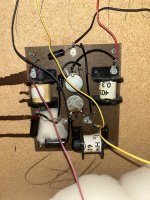 F7B18581-9E1E-4A65-8656-D3F2C2198D14.jpeg630.1 KB · Views: 510
F7B18581-9E1E-4A65-8656-D3F2C2198D14.jpeg630.1 KB · Views: 510 -
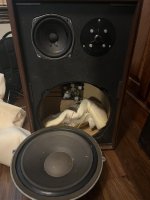 827256CC-BA26-45C1-8E55-01E64E3EE940.jpeg378.8 KB · Views: 466
827256CC-BA26-45C1-8E55-01E64E3EE940.jpeg378.8 KB · Views: 466 -
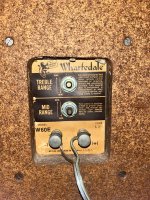 9D814157-2067-4CE9-AC34-EB5CDEB2B146.jpeg1,001.1 KB · Views: 432
9D814157-2067-4CE9-AC34-EB5CDEB2B146.jpeg1,001.1 KB · Views: 432 -
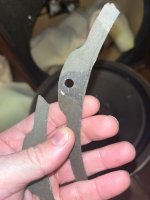 812F244C-9B3A-4907-A6AF-C17310BE0386.jpeg352.5 KB · Views: 304
812F244C-9B3A-4907-A6AF-C17310BE0386.jpeg352.5 KB · Views: 304 -
 314C06B7-8707-4141-868D-D13C10FA4A74.jpeg643.6 KB · Views: 324
314C06B7-8707-4141-868D-D13C10FA4A74.jpeg643.6 KB · Views: 324
Start with basics.
How exactly do they sound bad - is the sound balance off (e.g. not enough bass), is it distorted, too quiet..?
Have you checked to see if each individual driver works? e.g. if the mids are busted, but the tweeters and woofers are OK, it will sound bad, but it won't be immediately obvious why.
Do the L-pads work? If not, fiddle with them (sometimes they can be partly broken and cut out on some dial positions) or bypass them.
What do the surrounds look like? Some Wharfedale drivers has surrounds with a fairly open mesh cloth that was sealed with goo. When the goo dried out, the surrounds became leaky.
How exactly do they sound bad - is the sound balance off (e.g. not enough bass), is it distorted, too quiet..?
Have you checked to see if each individual driver works? e.g. if the mids are busted, but the tweeters and woofers are OK, it will sound bad, but it won't be immediately obvious why.
Do the L-pads work? If not, fiddle with them (sometimes they can be partly broken and cut out on some dial positions) or bypass them.
What do the surrounds look like? Some Wharfedale drivers has surrounds with a fairly open mesh cloth that was sealed with goo. When the goo dried out, the surrounds became leaky.
You can glue the gasket back together with PVA, just make sure it's dry before you reuse it. You'll almost certainly need to clean the level controls with Caig D5 or similar. If you bypass the attenuators the mids and highs will likely dominate the bass. Given the age of the loudspeakers the capacitors may be way off value or have high ESR, either of which will impact the sound quality. Modern electrolytic capacitors are cheap enough and good enough to just replace the originals with he same values as printed on the originals. The inductors will still be fine, unless there are poor solder joints.
Hi, new member - welcome to DIY Audio! By the looks of it from your 2nd. picture, the low-frequency driver (woofer) has a kind of rubber half-roll surround. This type of surround can become quite stiff over time; in fact, I have a pair of Wharfedale 12" woofers (among others of similar vintage) with a severe case of that exact problem. While it takes some familiarity (and ideally - test equipment) to ascertain the degree of degradation, be assured that a significantly stiffened surround will totally kill any bass output, and probably have other detrimental effects on the driver's sound. Sadly, I don't know of any effective treatment to restore hardened rubber surrounds (with a search you are likely to find a lot of discussion of this problem), but it should be possible to replace the surrounds with new ones (if you are up for some DIY craft!)
Oh - and if you plan to replace the crossover capacitors with electrolytics, be sure to use non-polar ones or an appropriate arrangement of polarized ones to give the same capacitance and equal or higher working voltage values.
Lastly, I have read anecdotal reports of those purple-dome tweeters also suffering from age-related deterioration (dome material degrades/becomes gooey), but have no direct experience to further corroborate that.
It looks like you've gotten a fun but not trivial project to dive into; hope it's a good learning experience to start your DIY Audio journey. There are plenty of very knowledgeable and helpful folks here to help you out. Good luck!
Wilf
Oh - and if you plan to replace the crossover capacitors with electrolytics, be sure to use non-polar ones or an appropriate arrangement of polarized ones to give the same capacitance and equal or higher working voltage values.
Lastly, I have read anecdotal reports of those purple-dome tweeters also suffering from age-related deterioration (dome material degrades/becomes gooey), but have no direct experience to further corroborate that.
It looks like you've gotten a fun but not trivial project to dive into; hope it's a good learning experience to start your DIY Audio journey. There are plenty of very knowledgeable and helpful folks here to help you out. Good luck!
Wilf
Thanks to everyone for the advice. Turns out that one of the tweeters was bad so I replaced both tweeters with some Dayton audio one that (almost) fit in the holes. I also replaced the capacitors with Dayton audio film caps. One of the l-pad is destroyed. I guess grandpa played these a little too loud. Can’t seem to find a replacement for a 50ohm pad. They do sound much better with new tweeters.
Attachments
You could simply bypass the 50 ohm pots - you may need the mid and treble at max volume anyway.
Last edited:
I edited my previous post as I now see that the top pot (treble control) is wired as variable resistor.
The bottom pot (mid control) is wired as a potentiometer (voltage divider).
Which one is destroyed?
The bottom pot (mid control) is wired as a potentiometer (voltage divider).
Which one is destroyed?
Yes, a 50 ohm, 5 watt, wire wound pot is a suitable replacement.
Note to SleepySantone: These controls are not constant impedance controls (L pads). At the time the W60E was produced, Wharfedale were still using simple pots.
Note to SleepySantone: These controls are not constant impedance controls (L pads). At the time the W60E was produced, Wharfedale were still using simple pots.
I had a pair of W60E's and regret selling them. They are wonderful sounding speakers. Mine were all original, including original caps. If they sound bad I would maybe look at the receiver first.
What receiver do you have?
What receiver do you have?
It is the mid control that is messed up. I think I will order the one provided next swap it out.I edited my previous post as I now see that the top pot (treble control) is wired as variable resistor.
The bottom pot (mid control) is wired as a potentiometer (voltage divider).
Which one is destroyed?
It is an early 80s Kenwood. I think I will hook these up to my modern receiver to see how much of a difference that makes. Was thinking about restoring receiver at some point. Thanks for the tip.I had a pair of W60E's and regret selling them. They are wonderful sounding speakers. Mine were all original, including original caps. If they sound bad I would maybe look at the receiver first.
What receiver do you have?
It is the mid control that is messed up.
That makes sense as it will be handling more power than the treble control.
Go for a higher power rating than 5 W if you can find one.
This UK supplier lists a 15 W, but it is "Currently out of stock, back in stock soon":
https://sinolec.co.uk/en/wire-wound-potentiometers/377-wire-wound-potentiometer-15-watt-50-ohm.html
- Home
- Loudspeakers
- Multi-Way
- Wharfedale W60E Sound Bad
